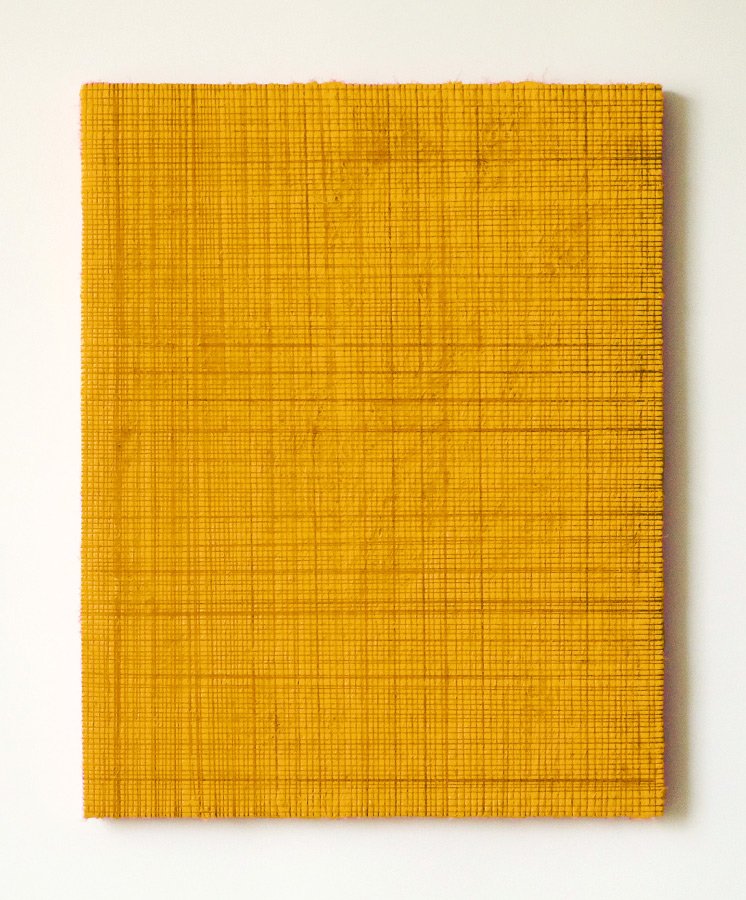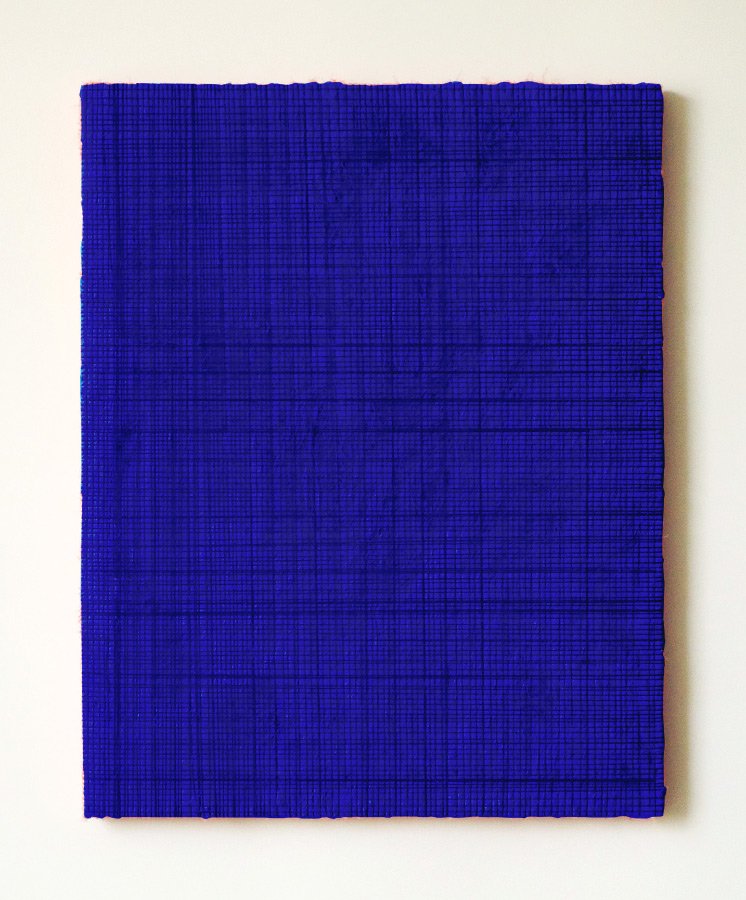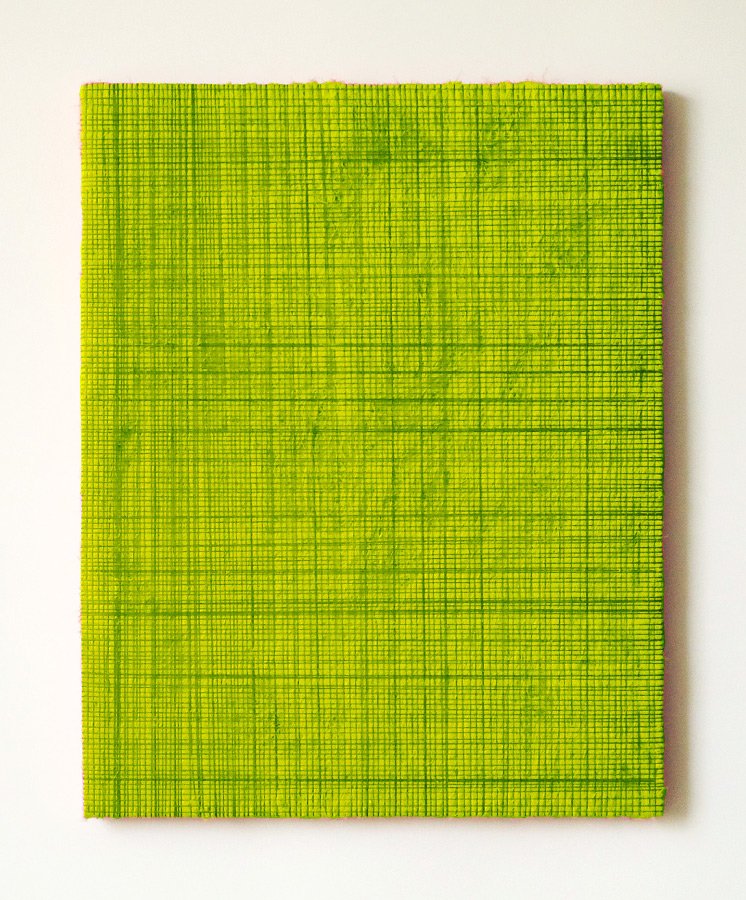RR-CC-1
Please select the artwork you want to see
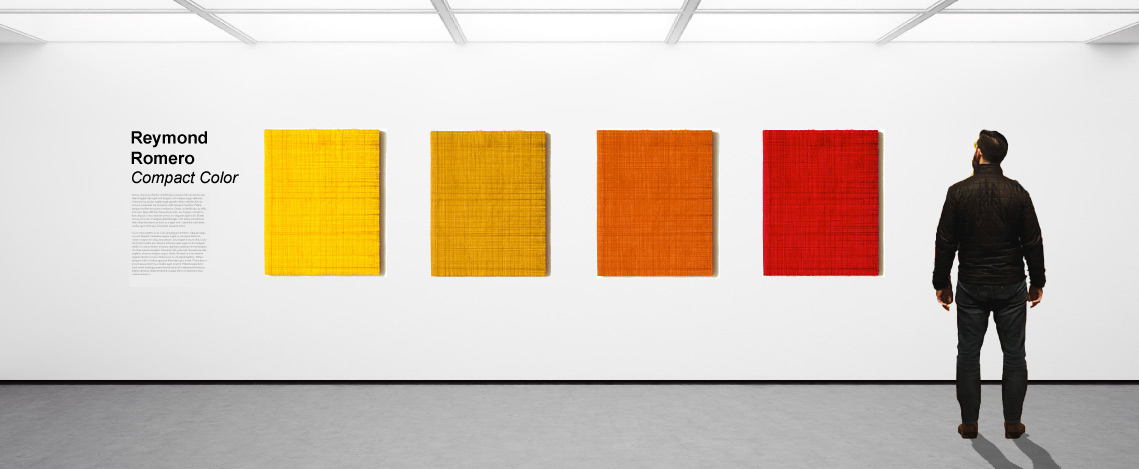
Curatorial Text
Reymond Romero
Compact Color
The aesthetic proposals of Reymond Romero (Mu00e9rida, Venezuela, b. 1979) respond to his endless exploration of color and the many possibilities that textile materials have to offer. It can be asserted that his work is structured over the tension between the fabricu2019s chromatic characteristics and the juxtaposition of fabrics, threads, and warp. This dialogue in Romerou2019s work is a route that allows for the opening of a space where different traditions converge and construct his vital genealogy as a young creator.
Regarding his relationship with tradition, it can be said that Romerou2019s explorations convey a particular discontinuity. He deals with ruptures that foster the diversity of roots that nurture his creative process, and a prodigal overflow of his emotional heritage. That is where Romerou2019s power and uniqueness reside: in the diverse, contaminated, earthy, rare, and dissonant nature of his oeuvre.
That is where Romerou2019s difficult, irresistible, seductive, and impure personality is imprinted. Reymond Romerou2019s work simultaneously presents a resistance exercise through the advancement of shapes, and an act of liberation and expression of totality through the expansion of shapes. In this sense, his work can be compared to the dynamic vitality of a breathing body, that inhales and exhales, that weaves itself through movement and rest. His objects and volumes are conceived as bodies. The nature of color in his work is corpuscular, like in celestial stars and atoms.
rn
Continue reading
rn
It is possible to point out that the work of Reymond Romero proposes a synthesis. That is why he arduously weaves images of peculiar beauty, but that are also charged with mystery. He explores and discusses formal limits from the possibilities of shapeless supports; he deals with the profound essence of things, and the complementary duality of beauty and human nature.
It is worth mentioning how the language developed by Romerou2019s work turns threads into a warp of bodies that challenge and expand the inherited possibilities of the different traditions that contains it. In his fascinating essay on the exhibition u201cNotes on paintingu201d, Luis Enrique Pu00e9rez Oramas discusses these ideas:
-
- rn t
- These objects have a special significance, because they summarize, in an exceptional way, an ability of formal connection with the tradition to which they belong; all hand in hand with a denominative resource and its thematic spirit, without any illustrative concession. Meaning, on one hand we have color u2013 and a Venezuelan tradition of color u2013 such as Cruz Diez, but also Luis Lizardo, one of the most influencing artists over the new generations of young artists in Venezuela; and on the other hand, the bodies, the body within its gender complexity u2013 male, ergo hairy; cosmetic, ergo dressed u2013 and a Venezuelan tradition of the art of bodies as objects of suture that has in Reveru00f3n, and in his dolls, the most illuminating predecessor of Romerou2019s own dolls. (1)
Pu00e9rez Orama explains the junctions of Romerou2019s work with the inherited idea of painting as a surface that contains an image, and points out how the fabric, acting as pictorial support, acquires a particular prominence. Hence, the use of textiles allows Romerou2019s work to generate an emotional and aesthetic experience that goes beyond painting itself, and that can be described as metapainting.
Pu00e9rez Orama also points out how, ironically, Raymond Romerou2019s only explicit reference to painting is found in the white space that surrounds every piece, u201cwhat is left of painting in his work is, literally, its place: the white wall that constitutes the neutral background of these u2018studiesu2019 and that contributes, through contrast, to build them as spatial articulationsu201d (2)
Having said that, it can be suggested that the character of Reymond Romerou2019s oeuvre becomes u201cinstallationalu201d, it assumes a dialogue with the space that contains it while adding meaning to it. Like bodies that are aware of their existence when they become present, these propositions create a particular grammar between space and place.
If it is possible to talk about u201ca neutral background that defines a pictorial characteru201d like Luis Enrique Pu00e9rez Oramas does, what would happen if the white space that identifies the place of a painting is erased in Romerou2019s work? What can be inferred if the expansive forces of the fabrics and threads, and of the knots and ties devour the preliminary space?
There is a transformational gesture in this impulse, a longing for expansion and completeness, and a hope for freedom. Romero wishes to
rn————————-rn(1) Pu00e9rez Oramas, Luis Enrique: u201cReymond Romero: Los hilos de la imagenu201d. Ensayo publicado en el catu00e1logo de la exposiciu00f3n Reymond Romero, anotaciones sobre la pintura, Galeru00eda Du2019Museo, Caracas, April 2007rnrn(2) Ibidemrn
erase defining limits in order to create an integrating totality. Under these parameters Reymond Romero conceived a virtual installation u201cCuerpos en Redu201d that complement 10 pieces of his u201cCompactosu201d series. This exercise represents a new move in Romerou2019s exploration, initially designed for the virtual space of the Galeru00eda BANG, but that may turn into the fulfillment of a long-time wish.
This new strategy, conceived as an innovative amusement, is based on a staging where images of u201ccompact bodiesu201d expand to take part of the space, and reminds us of the colonial Hispanic baroque in its aspiration of totality. There is no pictorial trace, there is no trace of the limit that defines the pictorial, and there is no neutral or empty background. There is no frame or stretcher left. On the contrary, all the threads extend like geological textures, like expanded chromatic roots, and overflow in the imageu2019s space. There are no borders left, no limits, only expansion, overflow, and mannerist bodies on stage.
It can be noticed the need of increasing the value of the legacy and constituents of traditional forms, of taking them to a different place, to an expansive, centrifuge, and baroque voluptuousness. It is possible to interpret Romerou2019s work like the execution of a profoundly contemporary visual concert due to its performance-like, emotional, and borderline libidinal nature.
In this way, Reymond Romerou2019s oeuvre continues the tradition and weaves a dialogue with Carlos Cruz-Diez, Luis Lizardo, and Armando Reveru00f3n, as Pu00e9rez Oramas stated; but it also does, even if less evidently, with the work of Venezuelan artists Miguel von Dangel and Josu00e9 Ramu00f3n Su00e1nchez, just to mention two other significant sources of inspiration.
There is not only tension and dialogue with certain aspects of the u201cbig discoursesu201d of the Venezuelan art tradition, but also with its complementary opposite, the tradition of discontinuity and of short stories. It is true that there is a special treatment of color in the work of Reymond Romero, but it is what can be described as a telluric and geological treatment of color. Or, as Maru00eda Luz Cu00e1rdenas stated: u201ccolor from withinu201d, color that is not light, strictly speaking, but it is instead a fossil incandescence that emerges from the depths to the surface, a shapeless color that, following again Luis Enrique Pu00e9rez Oramasu2019 idea, gives
————————-(3) Cárdenas, María Luz: “Reymond Romero: El color desde adentro”. Ensayo publicado para la exposición Reymond Romero, Acumulaciones Compulsivas, Galería D’Museo, Caracas, October 2016
Reymond Romerou2019s work independence and foster new horizons in his creative explorations.
When confronting Romerou2019s work, viewers enter in dialog with a restless spirit that shapes its language in the studiou2019s industriousness. His proposals hide the power of that which requires much more than good intentions to be shown. Indeed, some sarcasm, irony, and skepticism are needed to approach the experience that his work triggers.
Its warp and threads hide the bodies. Romerou2019s work harbors mystery and contains beauty both in the fabric and in its shapelessness. There is something hidden to the eyes that calls for touch. Skin is also a main character in experiencing color, as Pu00e9rez Oramas suggested, but the image is worth mentioning one more time. Through the fabric there is always a body that is hidden and it is shown. The fabric covers the body and turns it into a tangible surface and landscape. The fabric hides what complements us, what we desire. Maybe that is where the value of Reymond Romerou2019s oeuvre lies. It reminds us the nobility of the small, the beauty of fragility, and the virtues of a thread that can help us find our way out of the labyrinth.
rn
rnClick below to see in Spanishrn
Gerardo Zavarce
Curator
Pietro Daprano
Museographer
Compact Lemon Yellow
Compact Lemon Yellow
rnTextile and mixed media on canvasrn30 x 24 x 1.5 in.rn2018rn$ 3,800 Contact UsrnPlease click the image bellow to enlargern
Compact Yellow
Compact Yellow
rnTextile and mixed media on canvasrn30 x 24 x 1.5 in.rn2018rn$ 3,800 Contact UsrnPlease click the image bellow to enlargern
Compact Orange
Compact Orange
rnTextile and mixed media on canvasrn30 x 24 x 1.5 in.rn2018rn$ 3,800 Contact UsrnPlease click the image bellow to enlargern
Compact Red
Compact Red
rnTextile and mixed media on canvasrn30 x 24 x 1.5 in.rn2018rn$ 3,800 Contact UsrnPlease click the image bellow to enlargern
RR-CC-2
Please select the artwork you want to see
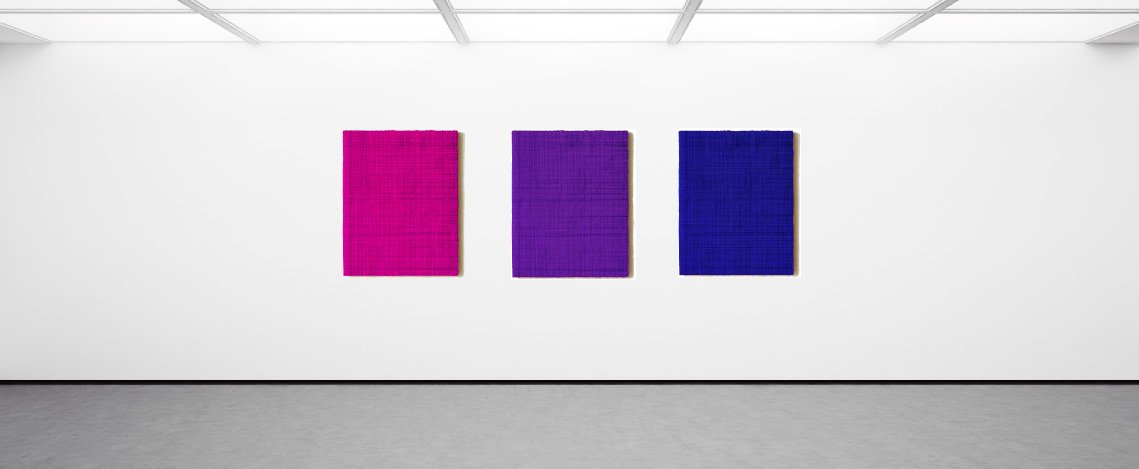
Compact Magenta
Compact Magenta
rnTextile and mixed media on canvasrn30 x 24 x 1.5 in.rn2018rn$ 3,800 Contact UsrnPlease click the image bellow to enlargern
rn
Compact Purple
Compact Purple
rnTextile and mixed media on canvasrn30 x 24 x 1.5 in.rn2018rn$ 3,800 Contact UsrnPlease click the image bellow to enlargern
rn
Compact Blue
Compact Blue
rnTextile and mixed media on canvasrn30 x 24 x 1.5 in.rn2018rn$ 3,800 Contact UsrnPlease click the image bellow to enlargern
rn
RR-CC-3
Please select the artwork you want to see

Compact Grass Green
Compact Grass Green
rnTextile and mixed media on canvasrn30 x 24 x 1.5 in.rn2018rn$ 3,800 Contact UsrnPlease click the image bellow to enlargern
rn
Compact Esmerald Green
Compact Esmerald Green
rnTextile and mixed media on canvasrn30 x 24 x 1.5 in.rn2018rn$ 3,800 Contact UsrnPlease click the image bellow to enlargern
rn
Compact Light Green
Compact Light Green
rnTextile and mixed media on canvasrn30 x 24 x 1.5 in.rn2018rn$ 3,800 Contact UsrnPlease click the image bellow to enlargern
rn
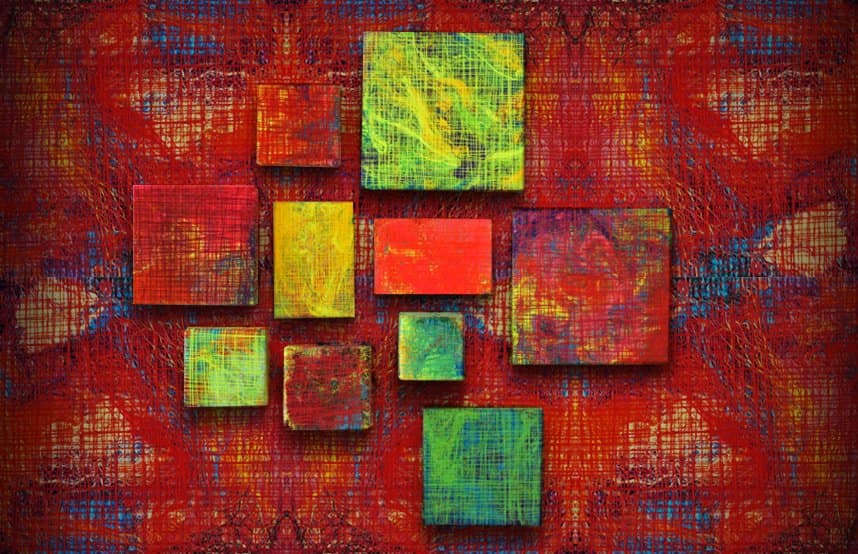
Installation of compact
Variable Measure
Textile and mixed media on canvas
2018


